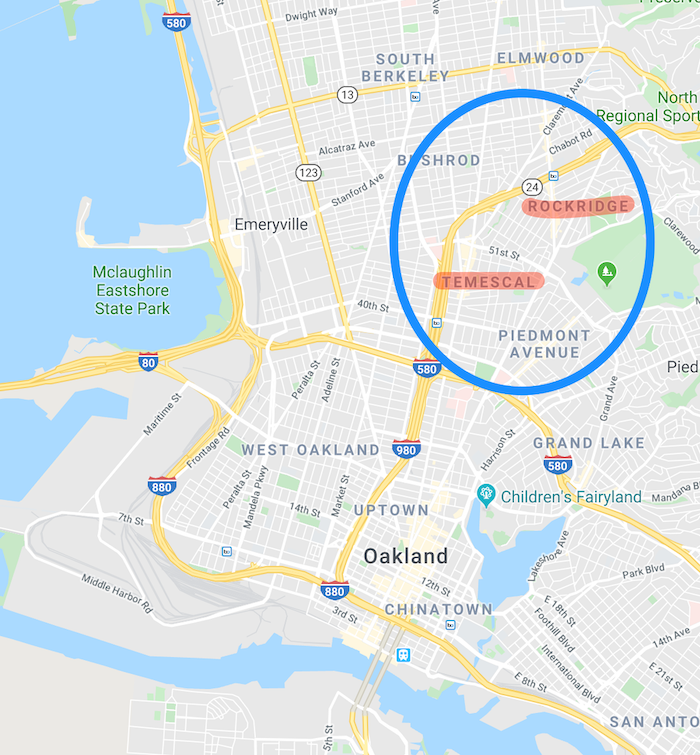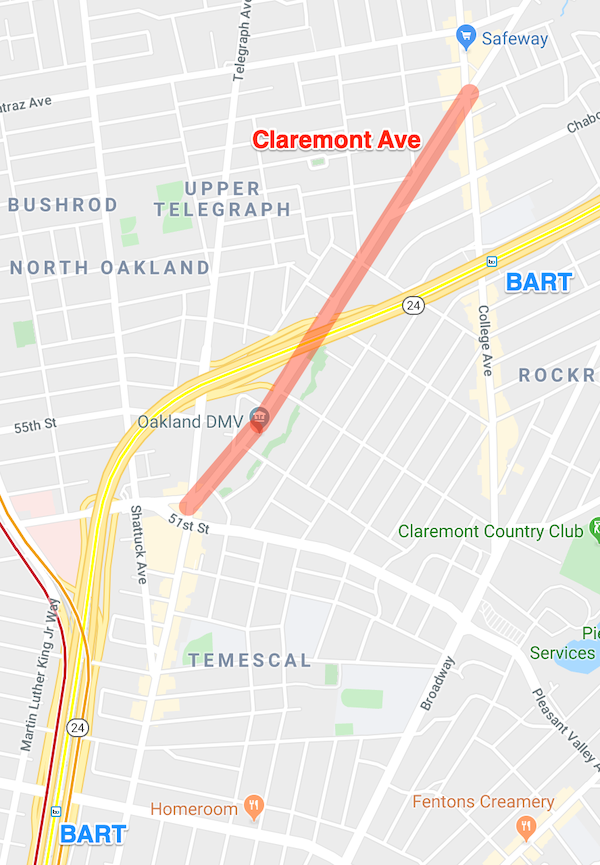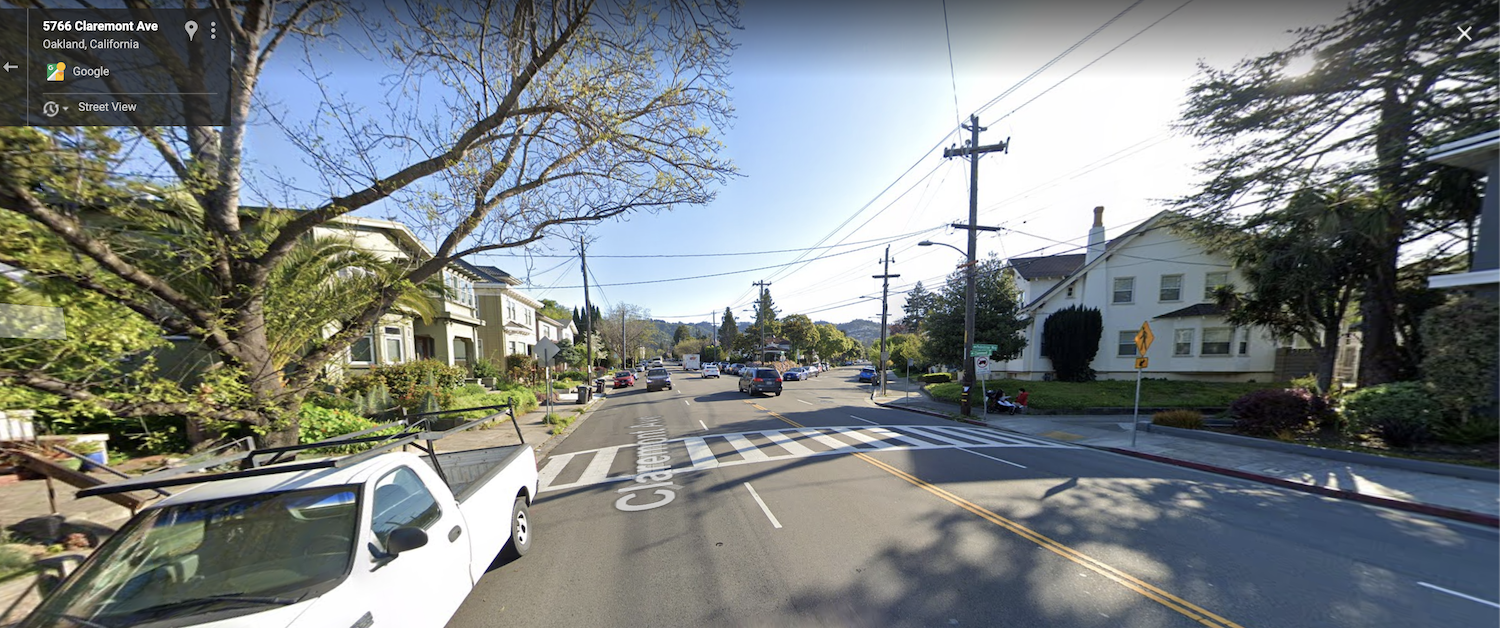Entering a new decade is a great time to set a vision for what you want the future to look like. One specific vision I’d like to set is right in my backyard in Oakland, California. It’s about the future of Claremont Avenue. Some small changes could:
- Improve safety for pedestrians and motorists
- Provide more flexible transit options
- Drive new economic development
- Better connect two vibrant neighborhoods
Background
Temescal and Rockridge are two neighborhoods located in the northeast corner of Oakland. Claremont Avenue is the diagonal road that connects the main street of Temescal (Telegraph) with that of Rockridge (College). This mile-long section has four lanes and is a busy thoroughfare.
Each neighborhood has a BART station and is undergoing a phase of rapid development. Single-family homes are slowly giving way to small apartments and mixed-use developments. The residents here want walkable neighborhoods and easy access to public transit. These neighborhoods are also a perfect fit for SB 50 - if it passes, the pace of development will accelerate.


The speed limit on Claremont is 30 mph, but it’s poorly enforced. There are few stoplights and many cars speed through this section to access the freeway. It’s dangerous for both motorists (a motorist died in April 2019 accident) and pedestrians. Residents north of Claremont must cross this street to get to and from BART each day on their commute. Of the 8 crosswalks, only the 3 at stoplights have a protected time to cross.

The street wasn’t always this way. Claremont used to have two lanes for vehicles plus two streetcar lanes in the middle. When the E Line of the Oakland Key rail system was removed, the street inherited two new dedicated lanes and hasn’t changed since.
Claremont 2030
It’s time to find a new balance for Claremont. Right now, the layout is 100% optimized for motorists. It is unsafe, doesn’t match the transit preferences of residents, and isolates these two neighborhoods. We could make Claremont a connector instead of an isolator.
While thinking about a solution, it’s important to think about the needs of motorists. With an entrance to Highway 24 and many adjoining neighborhoods, this road still needs to handle this volume. The solution needs to be a compromise.
My suggestion:
- A road diet to 3 lanes (one for each direction + a turn lane so traffic can stil flow)
- A bike lane, preferably protected by parked cars
- Bulb outs for pedestrian crosswalks
This is almost identical to the plan that has been approved for Telegraph Road in Temescal. That initiative identified the exact same problems - a Claremont project could almost be considered a Phase II of it. Here is an excerpt from the Temescal project’s executive summary:
“[The plan] guides the redesign of Telegraph Avenue to be a more complete street as follows: improving safety and accessibility of all modes; making the street more comfortable and enjoyable for walking and bicycling; and balancing the needs and convenience of all users, including transit and motorists.”
The safety benefits of a road diet are well known. I don’t need to push that argument, but it’s worth pointing out that neighboring streets would also become safer. Claremont’s low angle corners allow cars to enter residential streets at deadly speeds - Hillegass and Colby would see immediate improvements.
Here are some other reasons a project of this sort would be in Oakland’s best interest.
Economic
Rockridge and Temescal are distinct communities, but what about the middle of Claremont? It’s a drive-through zone. There are some small storefronts, but they don’t have the same economic prospects as College or Telegraph. Compare two mixed-use commercial buildings:
- 5555 Claremont Avenue sold recently at $408 per square foot
- 5324 College Avenue sold in 2017 at $617 per square foot
Both of these buildings are a seven-minute walk to Rockridge Station, but the College Avenue property is worth 51% more per square foot! It’s easy to imagine how these changes would make a more pedestrian-friendly street. Running a business here would be more attractive, and that would spur an economic boost.
Transit
MacArthur Station has become a regional transit hub. In addition to the multiple BART lines, many tech shuttle routes begin here. People across Oakland commute to MacArthur not just to ride BART, but also to get on a shuttle. Parking at MacArthur is already limited despite a new parking garage - it’s not a scalable option. It needs to be easy to get MacArthur via alternative forms of transit such as bikes and scooters. The Telegraph plan already recognizes this need.
If you live in Rockridge, there is no straightforward bike or electric scooter route to get to MacArthur, or even Telegraph. Walking to BART and riding it one stop can also be a hassle and difficult to plan with the timetable. Claremont is a direct path to Telegraph from north Rockridge - it should not be excluded from the vision of the Telegraph Project.
Community
Claremont is already the host of some sites that bring the two communities together. One example is the DMV Farmer’s Market, but there are not many others. The neighborhoods feel distant and isolated. Improved transit and development along Claremont would encourage more interaction between Rockridge and Temescal.
–
This is just a high-level idea. Like with all city planning and development, I know it takes time to consider the impacts of a project and sort out all the details. Hopefully, this can help set the vision for what should be accomplished in the next decade.